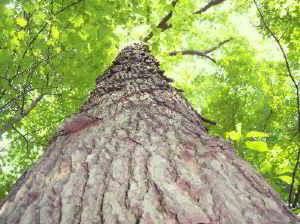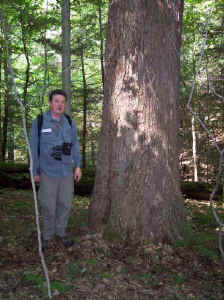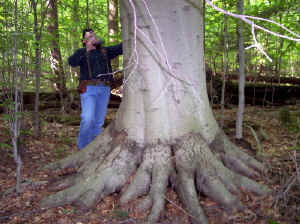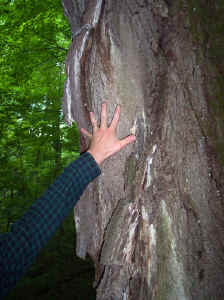McConnells
Mills State Park, PA
June 7, 2006 |
Edward
Frank |
| Jun
14, 2006 17:48 PDT |
ENTS,
On Wednesday June 7, 2006 Anthony Kelly, Carl Harting, Dale
Luthringer, and I (Ed Frank) met at McConnells Mill State Park
in western Pennsylvania to look for big trees. This party
represents all four people from western Pennsylvania actively
measuring trees. We had all be out exploring and measuring trees
in various combinations of two and three people, but I think
this was the first time all four of us had been on the same
trip. Dale was at the park to attend a Pa DCNR
Region 2 EIT/EES Meeting. The rest of us met him after the
meeting for the trip.
May first trip to the park was with Carl and Anthony on January
28, 2006 http://www.nativetreesociety.org/fieldtrips/penna/mcconnells2/mcconnels_mills_sp.htm
Anthony had made some amazing finds at the park and Carl had
contributed to the effort on several other trips. In May Anthony
reported a RHI10 of 130.62 effective May 13, 2006.
http://www.nativetreesociety.org/fieldtrips/penna/mcconnells_may06.htm
Part of the purpose of this trip was to show Dale the amazing
finds and to see if higher tops could be found on any of these
trees. I had planned on focusing on photography on this trip,
but accidentally left my compact flash cards at home in my card
reader, so I did not have any "film" for my digital
camera. Carl took photos which illustrate the main trip report.
I will not repeat the numbers we obtained on the trip, the nuts
and bolts are well described in Anthony's report. I want to
focus on some general impressions and observations of what was
found.
The first stop was to look at the 131.6 foot cucumber magnolia
tree near one rim of Slippery Rock Gorge. The short walk down
passes a number of large impressive oaks with broad sweeping
tops. Sugar maples, red maples, tuliptrees, and beeches were
also present in large sizes. The boundaries between what had
been more recently cut and the older tree area was quite
distinct, forming a wedge of older big trees among the younger
trees. Aside from the large cucumbertree, the most interesting
tree was a white oak located almost on the rim of the gorge. It
had thick branches beginning just a few feet off the ground.
Usually this is an indication of a tree growing in an opening.
Was this an old field tree? Did it grow in a natural opening? or
was its proximity to the open gorge responsible for the growth
pattern? To my untrained eye the tree seemed old. People were
living in the area in the late 1820's. That was 180 years ago,
so a tree left in a filed or growing on the edge og a field
dating from that time could still be very old.
Leaving this area we next went to the other side of the gorge to
what Anthony calls the "Big Woods" area. Here there is
a short trail across private land before reaching the park land
itself. The trail is used by horses and riders and is therefore
open and an easy walk. Here and there are trees that likely were
growing in old fields. Massive, heavy, low branched oaks are the
most spectacular. Farther along we abruptly hit a change in
character from younger forest to much older trees. We paused to
examine a large red oak in the 12 x 100 foot class along side of
the trail. We had discussions on the identification of slippery
(red) elm, and how to distinguish various types of hickories.
Several different hickory species are present in the area
including shagbark, bitternut, and pignut. We paused to measure
a modest sized sassafras - not a record holder - a tree for
which we have few measurements in the Pennsylvania database. A
large impressive black oak is growing aside the trail. In the
woods are black oak, red oak, chestnut oak, and white oak. All
of them grow to large size. Around the rim of the gorge the
white is impressive, not so much in size, but by how gnarled and
contorted it is in response to the weather blowing down the
canyon.

Cucumber in winter - photo by Ed Frank |

Cucumber in June - photo by Carl Harting
|
For me personally the size of the trees is impressive, but the
signs of age exhibited by some of the trees has an even greater
impact. One cucumber tree has shaggy bark extending up the tree
for at least 50 feet. In the winter we thought is was a
cucumber, but its expression was so unusual that we wanted to
see the leaves to remove the last vestiges of doubt. We looked
at black gum with deeply etched crevices between the bark
scales. There was a black walnut again with impressively shaggy
bark. Sugar maple kept in style with shaggy bark of its own.
There are large beech trees, with smooth gray bark, for the most
part unmarked by vandals and without signs of beech bark
disease. One large maple had moss growing thirty feet of more up
its trunk smoothed by balding. Some of the oaks had furrows in
the bark deep enough to fit your hand. There were trees with
staghead branching forming the vaulted canopy, There was a dead
basswood tree that had fallen across the trail. In the
chain-sawed end where the trail had been cleared, Dale counted
178 rings at a height of 19.2 feet above the base of the tree.
All the rings were close together, rowing with even finer bands
near the outer bark. How long does basswood live? I don't know.
Both large oaks and tuliptrees had many examples of thickly
furrowed bark on one side and balding to an almost smooth
surface on another. The impression was of age - true or false
these trees felt old.

Ancient sugar maple with mossy trunk - photo by Carl
Harting |

Carl Harting and Dale Luthringer examine the mossy
sugar maple - photo by Ed Frank |
One of the discussions we had was the old debate of whether this
was old growth or not. To some degree most of the eastern
forests have been impacted by human activities. The question
becomes in the east, how much impact can man have had before
something can no longer be considered old growth? Maurice
Schwartz at one time posted to the discussion list a post
listing 98 definitions of old growth he had located on the
internet. Was this area old growth? I suppose it depends on your
definition and how you interpret the landscape in front of you.
A nice discussion of the characteristics of old growth can be
found on the 500-year Forest Foundation website - http://www.designgroup.com/500yearforest/growth/index.htm I
am not sure if many of you have visited the website.
Here in the Big Woods area of mcconnells Mill State Park there
were no signs of stumps or other logging activities visible.
Anthony said there were two stumps visible in the entire area.
Dale felt that the area had been selectively logged at some
point in the past, but that the signs of the operation had long
since faded and the stumps rotted.
On the site we found many species that likely exceeded 150 to
200+ years in age: Cucumbertree, Tuliptree, Sugar Maple, Red
Maple, Northern Red Oak, White Oak,, and American Basswood. Dale
reported finding an Eastern Hemlock near the mill and some
American Beech that also might meet this age criteria. There are
some old looking Black Walnut in the park with shaggy bark.
Personally I want to add Black Gum and Chestnut Oak, but this is
only an impression with no hard support for the estimate. There
is a chance that other species besides these may reach similar
ages in the park. There is no way to look at a tree and say this
tree is exactly this age - an educated guess is made based upon
what we know are characteristics of old age. There
was an uneven aged canopy - older fat trees mixed with younger
skinnier ones. There were downed logs on the forest floor.
Perhaps there were not as many as can be found at places like
Cook Forest, and the distribution of the downed logs varied from
areas with few to areas with many downed logs. There were
occasional standing snags among the trees, but they were few in
number. What does this tell you? Are they absent because of
human activities or absent because of local conditions?
Pit and mound topography: There are some pits and mounds related
to tree falls. I personally am not sure how definitive that
characteristic really is. The time duration of the tip-up mounds
would be dependant on the type of soil present on the site and
the species of trees involved. It is dependant on the speed of
erosion and other mass wasting processes on the site. Areas
containing float blocks of large rocks can easily be mistaken
for pit and mound topography, especially if covered by a layer
of soil or moss.
Other characteristics: There were some treefall
gaps. There seemed to be a diversity of trees and plants, we did
not search for amphibians or invertebrates. There were a number
of different bird calls and small squirrels and chipmunks
present. We saw white-tailed deer. There were signs of other
mammals.
One classification system mentioned by Dale involved determining
whether or not here were at least 6 to 7 trees 150 years or
older per acre. An acre is a circle just under 120 feet, or 40
yards in radius. In this area that was generally a circle about
as far as you could easily see through the trees. There were
commonly 5 trees per acre that made this age category - if our
age estimates were right. There were big tuliptrees scattered
everywhere, but were likely not be old enough to meet the 150
year criteria. Is it old-growth? I still don't know. It is a
matter of what definitions you use, and what interpretations you
make of what you see.
On future trips to the area I would like to measure more of the
mid-to-small sized trees of other species I could see growing in
the area to better characterized the diversity of trees present
on the site. I would like to better document photographically
some of the old-age characteristics exhibited by some of these
trees. Examples like these are extremely uncommon. I would want
to make sure that the GPS location of the trees I photographed
were taken. I am convinced that there is a state record beech
tree in the area, given the large number in the upper 110's and
low 120's. Anthony has looked, and so have Carl and I, without
luck, but still...
Ed Frank
|
RE:
McConnells Mills State Park, PA
June 7, 2006 |
Anthony
Kelly |
| Jun
15, 2006 20:32 PDT |
Ed, Ents,
Ed, good synopsis of our day at McConnells Mill State Park. Like
you said,
it was great to have all four Western PA ents together on one
outing. I was
especially happy to finally show Dale some of the big tree areas
that I'd
discovered in the park and get his opinion on them. He was also
able to
verify the species of certain tall trees about which I'd had
some doubts.
Regrettably we were only had about fives hours, so I was only
able to show
him the highlights. I've so far spend about 100 hours exploring
the park
and have found a lot of incredible trees which we weren't able
to get to on
this trip.
As Ed reported, first we visited PA height record cucumbertree
on the
southern bank of the Slippery Rock Creek Gorge which runs
through the park.
I first discovered the tree back in November. Ed Frank, Carl
Harting, and I
had measured it in January and settled conservatively on 130.3'.
Dale
remeasured it twice last Wednesday getting 131.5 both times. We
averaged
this with a number of previous measurements that I had done and
got 131.6',
which we decided is probably the most accurate estimate for the
height of
the tree.
Incidentally, as we pulled up to park along the road a couple
hundred feet
from this tree, Dale recognized the Road Closed sign and
remarked that he'd
already stopped there on one of his previous trips to the park.
For whatever
reason, though, he decided that it wasn't worth getting out and
exploring.
Unfortunate decision. He'd just missed discovering that whopper
cucumbertree himself!
After our visit to the cucumber, we were off to the "big
woods" section, as
I've heard the local folks call it. I've reported on this area
extensively
in past posts. It is a relatively flat area (supposedly 75
acres) that
abuts the Slippery Rock Creek Gorge along part of its northern
bank. It
contains among other specimens a number of fat Red oaks with
>10ft girths
(largest 13.5'X110.1'), about a dozen Tulip Poplars >130ft
tall (largest
10.8'X146.0') some of which have very deeply furrowed bark,
several large
cucumbers and tall beeches, and a number of very old looking
black gums, one
of which is a PA height record (6’4”X110.6').

Champion
Cucumbertree with Anthony for scale - photo by Carl Harting
In contrast with most of the sites down inside the gorge itself,
this site
is hardly inaccessible. It's always been a mystery to me why it
contains so
many large and tall trees. It is clear where the old property
lines were
from the abrupt changes in tree size and the presence of stumps
in adjacent
areas. Though I usually referred to it as
"old-growth", I have questioned in
previous posts how "virgin" the site is never
believing that it was
completely untouched. I've explored about 80-90% of its reputed
75 acres
and have only seen two very old stumps. I've always assumed that
the farmer
that settled that land, and the subsequent owners kept that
piece as a
timber reserve only taking out a tree here and there over the
years as they
needed lumber. I doubt that it was ever clear-cut as there are
some trees
that show very old bark patterns and other signs of advanced
age.
As Ed reported, Dale stopped short of classifying this
particular area as
old-growth, noting that there is a lower density of old trees
than is
normally considered necessary for a forest to be strictly
considered
old-growth. He believes it must have undergone at least some
logging if
very long ago.

Dale looking
at large American Beech - photo by Carl Harting
Actually, I’ve just thought of another possible factor in
addition to human
intervention that might help account for the low density of
older trees.
Perhaps the area contained a lot of American Chestnut trees that
would have
been lost in the early 1900's leaving big gaps. Just a
speculation.
Another thing that has always been a mystery to me is the lack
of hemlock
trees outside of gorge and its deeper tributary ravines. Even in
those
riparian areas that do contain hemlocks, there are no large ones
like you
see at Cook Forest or other Central Pennsylvania sites. Were
they all
harvested at one point? If this were true, I would imagine that
there would
now be at least a few younger ones scattered around, but there
are not. Is
it because this is simply a different forest type? The geology
of the area
is more like that of flat Ohio than mountainous Central PA.
Would that
account for it? I'm not at all familiar with this part of the
state. The
lack of hemlocks is probably normal for this area. I'm probably
just too
used to the Allegheny Mountain forests.
Just below the big woods area down inside the gorge is an area
known as
Walnut Flats which we accessed by an old wagon road. As
I've said in a
past report, Walnut Flats contains some of the tallest trees in
the park
including two PA height records (American Basswood,
6'5"X127.1'; Slippery
Elm, 9'0"X127.0').
The species content of this area is much different than the big
woods area
just on top of the gorge. In Walnut Flats there are numerous
American
basswoods, bitternut hickories, white ashes, sycamores, and
sugar maples
with a few Slippery Elms and, of course, Black Walnuts scattered
about.
Tulips and beeches are plentiful, as above the gorge, but oaks
are few. The
old-looking, moss-covered maple pictured in Ed's website report
is down
there, as is downed American basswood cutaway whose ~180 rings
Dale and Ed
counted. I don't believe that they measured the girth of that
log. I'll
make it a point to do so on my next trip. (I found a
larger-girthed living
American basswood in another part of the gorge measuring
9'3"X118.4'. It,
too, is ancient looking.)

Rough barked
black walnut - photo by Carl Harting
Though Dale balked at classifying the big woods section as
old-growth, he
had no trouble considering Walnut Flats and much of the forest
down inside
the gorge as such. Here as in many other areas inside the gorge
the trees
show a lot of very interesting bark and branching patterns. My
two favorite
trees in this area are the maple mentioned earlier and a black
walnut tree
with deep large sections of bark peeling off in thick twisted
plates. Dale
said that he’d seen that character before but never as
pronounce as on that
tree.
Because of the sizes of many of trees, it’s easy to become
distracted and
forget to notice some of these more unusual characters that
don’t always
appear on the largest trees but that in many ways are a lot more
interesting
than sheer size. As I spend more time at McConnells Mill, I’m
learning to
appreciate these features more.
We didn’t measure many trees this trip. A number of the ones
we did measure
were re-measures. Below is a list of trees measured either on
this trip or
on my own recent trips that I haven’t yet posted. I plan post
a
comprehensive list of all the trees we’ve measured at
McConnells Mill soon.
Species CBH Height Measurer(s)
Black walnut 10.1 110.9 Luthringer
Cucumbertree 10.3 131.6 Frank,
Harting, Kelly, Luthringer
N. red oak 12.6 107.5+ Luthringer
Pignut hickory 4.4 96.9 Luthringer
Red Maple 7.9 107.4 Kelly
Sassafras 3.9 63.7 Luthringer
Slippery Elm 9.0 127.0 Kelly
Sugar Maple 8’8” 123.0 Kelly,
Luthringer
Slippery Rock Creek Gorge
Rucker Index as of 6/11/2006:
Tulip Poplar
10'9" 146.0' (Kelly)
White Ash 6'7" 137.7'
(Kelly)
Sycamore
9'0" 137.5'
(Kelly)
Bitternut Hickory 5'10" 132.7'
(Kelly)
Cucumbertree 10'2" 131.6'
(Frank, Harting, Kelly, Luthringer)
Am Basswood 6'5" 127.1'
(Kelly)
S. Elm 9'0" 127.0'
(Kelly)
N. Red Oak 9'7" 123.1'
(Harting)
Sugar Maple 8'8" 123.0'
(Kelly, Luthringer)
E. Hemlock
n/a 122.8'
(Luthringer)
Rucker Index = 130.85
PA height records in Slippery Rock Creek Gorge Area:
Am Basswood 6'5" 127.1'
Cucumbertree 10'2" 131.6'
S. Elm 9'0" 127.0'
Black Gum 6'4" 110.6'
Thanks,
Anthony Kelly
|
Re:
McConnells Mills State Park
PA, June 7, 2006 |
Edward
Frank |
| Jun
16, 2006 07:09 PDT |
Anthony,
Nice article. I will comment more later. Just one point about
the chestnut
speculation. Definitely not loss of chestnuts. If they had been
present
the logs stumps, and many standing chestnut snags would still be
present.
Any place that had chestnuts still show these characteristics as
if it were
only a short time ago due to the resistance to rot of the
chestnut.
Ed
|
RE:
McConnells Mills State Park, PA
June 7, 2006 |
djluth-@pennswoods.net |
| Jun
16, 2006 21:29 PDT |
Anthony,
Yes, I definitely got 'scooped' on the new cuke' record. That's
what I
get for not planning enough time in my day for a little extra
measuring
time in the woods. That cucumber is truly worth its NE height
champ
status!
Tulips at McConnells Mill have the potential to reach great age.
There
was a large tuliptree cross section taken from one of the
harvested
tulips within the park which is now located at the old mill that
went
well over 300 rings (darned if I can't remember the number,
forgot to
right it down) to a hollow ~4" center.
The 8'8" x 123 sugar maple height was only shot 1x from
directly
underneath through full leaf cover. This tree has potential to
be new
state height record if more thoroughly measured after leaf-off,
or if a
new window farther away from tree is found. The current PA
height
record is 126.1+ft located in Wintergreen Gorge behind Penn
State
Behrend.
Great job, Anthony! That was a splendid day in the woods. Can't
thank-you enough for superb guided tour of the area.
Dale
|
|